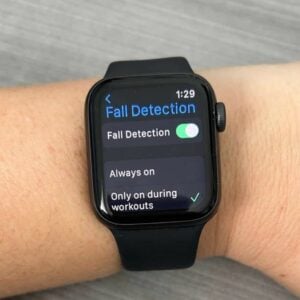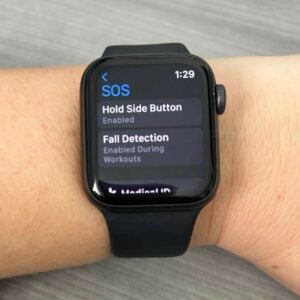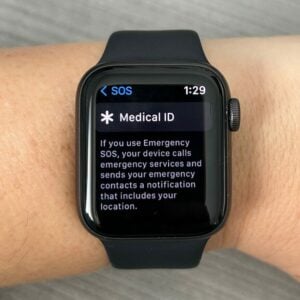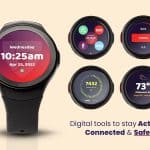
Here’s where you turn fall detection on and off on your Apple watch. You can activate fall detection starting with the series 4.
As technology advances, seniors have access to more and more options when it comes to monitoring their health, safety, and wellbeing. The latest tech news was first introduced with the Apple Watch Series 4 and continues with the Series 5, Series 6, Series 7, Series 8 and now the Series 9 which was released in mid-September 2023. Much like the iPhone, the Apple Watch keeps evolving over time, providing better information technology features to users.
Apple Watches are renowned for their innovative features, and one standout capability is their fall detection technology. To understand how this wristwatch can help seniors, you have to understand the latest technology they have built into the watch. That technology is an accelerometer and gyroscope that measures up to 32 g-forces. This fall detection algorithm can determine if your loved one has suffered from a fall and will call for help automatically.
Apple Watches can intelligently identify when the wearer experiences a significant fall. The more information you have at hand, the more you can understand the fall detection technology. Read on for a complete breakdown!
My Personal Apple Watch User Experience

This is the Apple Watch fall detection screen on my Series 6.
As an Apple Watch user myself, I currently own the Apple Watch Series 6. Being an active 40 something, I love being able to track my fitness and workout goals with the watch. I’m also comforted knowing that if I do suffer from a slip or fall, my watch will be able to call for emergency help. Here are a few photos of me wearing my watch on my wrist showing just how user friendly the apple watch’s screen is.
To be sure the Apple Watch is setup properly, go under the settings app, and select SOS, which is were I’ve added my Medical ID and I’m able to turn on or off the Fall Detection feature. You can also see that the screen allows me to choose if I want it active only during workouts. Overall, I find the watch lightweight, comfortable to wear and a great addition to my Apple collection.
Managing Falls on the Apple Watch
If you have an Apple Watch Series 4 or above, fall detection technology is already available to you. Here are the tips you can use in order to manage the feature on your device.
What Are Fall Detection Devices?
Fall detection technology is not only available on Apple devices. In fact, the technology has been around for some time and has been used primarily in the medical alert device industry, helping to provide assistance to older adults who typically live at home alone. However, fall detection can benefit people of all ages, especially if it is conveniently available on their Apple Watch.
Let’s dive into fall detection technology a bit.
Many people ask, “how does fall detection work?” The accelerometer and gyroscope are the technology responsible for automatic fall detection in medical alert device pendants. These sensors detect your everyday activity and can sense a falling motion. It is also built into many other devices you may own such as your smartphone. An accelerometer measures the change in your velocity or speed divided by time. Think about when you change the position of your smartphone and the orientation of your screen changes with it. That is the accelerometer technology at work! According to LiveScience, a gyroscope is a device that uses the Earth’s gravity to help determine orientation. Both of these applications working together can work effectively to detect falls in seniors via a pendant, smartphone, watch, or other device.
Why Is Fall Detection Important?
According to the CDC, over 800,000 seniors are hospitalized due to an injury from a fall. Seniors who suffer from falls can easily break a hip and that may lead to other complications. Falls are also the leading cause of death from injury among adults 65 and older. With the integration of this technology in devices such as an automatic fall detection pendant, fall detection watch or the new Apple Watch, falls can be treated quickly and hopefully more efficiently to help prevent some of those death by injury falls. In fact, a man in Spokane, Washington credits the Apple Watch for saving his father who fell off his bicycle and was left unconscious. The Apple Watch detected his fall and called his emergency contacts as well as emergency services who were able to find the man and take him for treatment.
How Can the Apple Watch Fall Detect Falls?
Although this technology has been built into smartphones for a while, the difference is the new Apple Watch claims to have created custom algorithms to more accurately sense when a fall has taken place. One of the criticisms of automatic fall detection in the past has been that it is not always accurate in detecting falls with one recent study showing it detected 12 out of 15 actual falls.
With this new Apple Watch feature, if it senses the user has been immobilized, it will give you an option to choose if you are ok or if you want to call emergency services. If there is no activity for more than 60 seconds, it will automatically call for help from emergency services and send your emergency contacts to your location. Getting help fast in these emergency situations is often times key for potentially saving someone’s life.
While fall detection has been in Apple Watches since the Series 4, there have been significant improvements for each new iteration. Apple continued to improve its fall detection technology for the Series 7. It enhanced the algorithm and optimized the technology to become more accurate. The Series 7 still features the alert on the watch if it recognizes a hard fall, giving users the opportunity to call emergency services right from the watch.
However, now the watch can also notice if the user falls while working out, meaning a hike, bike, or even Zumba class can now be safer thanks to Series 7 fall detection technology. This fall detection option adds a valuable layer of safety and peace of mind, showcasing how technology, in the form of wearables like the Apple Watch, can play a crucial role in health and well-being.
Why Use an Apple Watch With Fall Detection?
People who are at an increased fall risk due to medical challenges, age, or mobility concerns can find peace of mind knowing their Apple Watch will check in with them to see if they are okay after a perceived fall. The automatic fall detection feature can also provide the user with emergency assistance if they say they need it, or if they are unconscious and unable to say whether or not they feel they need it. It will also give your exact location to emergency services thanks to built in GPS. This can increase response time and hopefully result in quicker treatment from first responders.
However, the feature isn’t just for those who are older or have mobility or medical challenges. While not all Apple Watch users are at risk for a fall, having the feature readily available might come in handy in a scary situation, such as an unexpected seizure, fall, or car accident.
Who Can Benefit From Automatic Fall Detection Technology?
Apple Watch fall detection technology can be particularly beneficial for various individuals across different age groups and lifestyles. Here are some groups that can benefit:
- Seniors and Elderly Individuals: Seniors are often more susceptible to falls due to factors like reduced mobility and balance issues. Automatic fall detection provides an extra layer of safety, ensuring prompt assistance in case of an emergency.
- People with Medical Conditions: Individuals with medical conditions that may lead to sudden falls, such as epilepsy or certain cardiovascular issues, can benefit from automatic fall detection as it offers a quick response mechanism in critical situations.
- Athletes and Outdoor Enthusiasts: Those engaged in physical activities, such as hiking, running, or biking, can benefit from fall detection in case of accidents during their pursuits, especially in remote areas where immediate help may be challenging to obtain.
- Individuals Living Alone: People who live alone may face challenges in getting help quickly in the event of a fall. Fall detection technology can be a crucial lifeline for them, ensuring that emergency services are alerted promptly.
- Workers in Hazardous Environments: Individuals working in environments with a higher risk of accidents, such as construction sites or industrial settings, can benefit from fall detection as an added safety measure to mitigate the consequences of workplace accidents.
- People Recovering from Surgery or Injury: Individuals in the recovery phase after surgery or injury may experience temporary limitations in mobility, making them more prone to falls. Fall detection can offer extra protection during this vulnerable period.
Manage Fall Detection on the Apple Watch & Use the App to Turn Fall Detection On or Off
If you have an Apple Watch Series 4 or above, fall detection technology is already available to you. Here are the tips you can use in order to manage the feature on your device.

This is where I enabled fall detection on my watch
Fall detection is enabled automatically if the birthday you entered when registering your Apple ID indicates you are 55 years of age or older. If you are younger and want fall detection enabled on your watch, you can turn it on with a few quick steps.
To turn fall detection on:
- Go to the Settings app on your watch.
- Tap SOS > Fall Detection.
- Turn the fall detection feature on.
You can also do this via your iPhone by going to My Watch, and then Emergency SOS. Turn on fall detection.
You’ll have the option to turn fall detection to “always on” or “during workouts”. If you have a watch Series 8 or above, the operating system already is enabled to begin fall detection during workouts for those between the ages of 18 and 55.
Prefer to have fall detection turned off? Follow the same instructions and just select “off”.
Set Up Your Watch Medical ID and Add Emergency Contacts

This is my Apple Watch Series 6 showing where you can access your medical ID.
The Medical ID feature can be quite helpful in case of an emergency situation. First responders can see your medical information from your lock screen if you give that permission. It can also be a convenient way to store medical information that you might want easy access to.
Your Medical ID profile can be accessed on your iPhone. Go to Settings > Health > Medical ID. Here, you can adjust information and add or delete emergency contacts.
Be sure your birthday is entered into your profile and that it is correct. You can add medical diagnoses or conditions as you wish here, as well as allergies or other notes. You can also list medications you are currently taking. Just use the green + sign to add another medication or delete one you no longer take by using the red – sign.
To add an emergency contact, tap the green + symbol under the emergency contacts section. You can add a name and contact information here. To remove any contacts, use the red – button.
Finally, if you’d like your Medical ID to be shown when your phone is locked, be sure to turn on “show when locked”. This is the best option for someone who wants to be sure first responders can see that important information.
After your edits are complete, tap “done”.
Set Up Other Emergency Features
There are a few other emergency features of the Apple Watch devices that you might find useful. The first is Emergency SOS, which gives users the opportunity to dial emergency services right from their watch or phone, even if the device has not detected a fall. After the call to emergency services, the device sends information about the call to the emergency contacts listed in the user’s Medical ID.
To use Emergency SOS on your watch, press and hold the side button on your watch until the emergency menu pops up. Drag the SOS icon to start the call right away. If you can’t do that, just hold the side button and the call with start automatically after a few moments.
What Else Can the Latest Apple Watch Do?
Another great feature of the Apple Watch is a heart sensor app that can take an EKG in real time. This is the first direct to consumer device with that heart monitoring ability. It also monitors the heart for any irregularities. The biometric data the watch is collecting is stored within the device and can be sent directly to your health care provider. Starting with series 7 and up are also senior friendly as the display is significantly larger and the speaker is 50 percent louder than previous models, making sounds and notifications easier to hear and buttons less difficult to press. This makes typing easier for those living with fine motor challenges as well as seeing the screen for those with low vision.
The latest series also appears to be more durable. It is still water resistant, which is helpful for seniors choosing to wear their watch in the shower or pool. It is also crack resistant, which means it will likely last longer before needing any repairs to the screen.
Since the release of the Series 4, Apple has really focused on creating health and wellness support with its devices. Starting with the Series 8 it was no different. Beyond the EKG features, similar to the Series 8, the Series 9 can also take on-demand blood oxygen levels and detect any irregular heart rhythm. This data can be used to give the user peace of mind or to document the readings to share with a physician. Similar to the Series 6 through 8, the Series 9 also offers programs that can help with sleep and consistent routine, measure exercise or fitness goals, and communicate with family members who are on the same plan.
The Apple Watch also features a medications app that will push notifications when it is time to take medications or vitamins, starting with the Series 8. It also allows the user to quickly log if they have taken them. This is especially handy for older adults who might struggle with keeping up with their medication schedule.
In addition to the new Apple Watch features, the watch can be used as a smartphone, and as a way to send messages to friends and family. There are many conveniences of an Apple Watch including being able to use the handy Apple Pay feature, which allows for a quick tap of the watch to pay for goods and services as well as being a fitness tracking device, making it the perfect Apple Watch for seniors. You can also download apps and games that are of interest to you, and set up a Medical ID on your watch. Apple Watch, just like the iPhone, comes with the Siri option which allows for hands free calls and texts. See Apple Watch & Fitbit Bring New Era of Health Monitoring Devices for more things you can monitor!
Apple Watch Cost vs. Medical Alert Alarm Monitoring
These new Apple Watch features could give medical alert companies a run for their money. The cost of the latest Apple Watch Series 8 starts at $399 for the aluminum case with sport loop version, with the stainless steel case with leather link version beginning at $749. A typical medical alert monitoring system can range anywhere from $19.99 a month for a basic system to $89.99 a month for top of the line medical alert monitoring services that includes monitoring falls. Keep in mind, you are paying for professional monitoring services with a traditional medical alert company. The Apple Watch will simply call 911 emergency services to respond to your medical alert emergency. It does not include monthly monitoring services.
Apple Watch Series 4 vs. Series 5
There is not much new with the Apple Watch Series 5 if you are considering an upgrade from the Series 4. The Series 5 continues to have the same break-through technology as the Series 4 with regards to fall detection and EKG heart rate monitoring app. The Series 5 watch does have a new feature built into the back of the watch and has electrodes built in the digital crown. When you touch it, it will generate a waveform and can indicate if you have signs of an irregular heartbeat such as atrial fibrillation.
Another main feature that is new is the always-on Retina display. The Series 5’s display is always on without you having to physically turn it on. It dims when you are not looking at it to save on battery life. There is also a lot more storage with the Series 5 (32GB) compared to the Series 4 (16GB).
One of the other brand-new features is the Noise app, available with watchOS6 and later, which can indicate when noise levels have risen to an unsafe level. The good news is that this is available with the Series 4 watch and later.
If you have the cellular version of the Series 5, you can use the international emergency calling feature. If you have an emergency when traveling abroad, simply press and hold the side button to be connected to emergency services.
Lastly, the Series 5 comes with a brand-new Compass app that even works if you don’t have a Wi-Fi or a cellular connection. The app will show your direction, elevation, incline, latitude and longitude. Unfortunately, this feature is not available with the Apple Watch Series 4.
Apple Watch Series 5 vs. Series 6
Apple began dipping its toe into health and wellness monitoring in the Apple Watch Series 4. The Series 5 launch kept the electrical heart sensor and optical heart sensor while improving the irregular heart rhythm notification system. The Series 5 also improved upon fall detection technology and emergency alerts. However, the improvements that came when the Series 6 launched were very impressive.
The Series 6 features the third-generation optical heart sensor which only improves readings for the user. It also allows for the ECG function and blood oxygen readings, which the Series 5 does not. The fall detection algorithm is also more advanced and optimized in the Series 6 than in the Series 5. In general, the Series 6 is a much more innovative piece of technology than the Series 5 when it comes to health monitoring and fall detection.
Apple Watch Series 6 vs. Series 7
While the Series 6 and Series 7 came out just one year apart from one another, there are some serious improvements that accompany the newer model. First, the display is much larger on the Series 7 than the Series 6. This is a big improvement and makes texting, tapping, and reading the display much easier for Series 7 users. For older adults specifically, this change in the display size can accommodate low vision challenges as well as fine motor obstacles that were apparent while using the Series 6.
Both the Series 6 and 7 are water resistant and durable, though the Series 7 does boast dustproof and crack-resistance making it more durable during daily use.
Similarly, both the Series 6 and 7 offer health monitoring applications ranging from ECG and blood oxygen levels to notifying the user if there are any irregular heart rhythms.
Apple Watch Series 7 vs. Series 8
While it can sometimes be difficult to compare newer versions of the Apple Watch, there are some wonderful additions to what the Series 8 offers that can make it a much more friendly option for active seniors.
For example, while the Series 8 has the fall detection and SOS features that the Series 7 does, a new safety feature is crash detection. Using its microphone, GPS, and barometer, the Series 8 can detect if the user is in a potential car crash. If it is detected, it will automatically connect the user to emergency services, provide your location to dispatchers, and even notify emergency contacts. For older adults who drive, this is an added layer of peace of mind that we love.
When it comes to health and wellness, we like that the Series 8 continues to offer blood oxygen level monitoring and ECG monitoring as the Series 8. But we also like the addition of the medications app push notifications to the device as well as how it coordinates with the Health app. The Health app not only gives users the chance to store their health information, it also helps the user understand what their individualized readings mean to them and their wellness goals.
The Apple Watch, as long as it is Series 4 or newer, offers a real alternative to medical alert devices. Consider which ones might be best for your current needs and budget.
Apple Watch Series 8 vs. Series 9
The latest Apple Watch has a new S9 SiP chip that can process machine learning tasks up to two times faster than before. This allowed Apple to release a new “gesture” called Double Tap. Double Tap allows you to do things like answer a phone call and pause music by double tapping your index finger and thumb together. It also has twice the screen brightness than the Series 8 so it will be easier to read.
Siri requests and commands are faster and up to 25% more accurate too so you can have a better hands-free experience with this version. You can use your Apple Watch 9 to securely ask about or update your weight or find out how well you slept the night before. You can also get more precise location of your misplaced iPhone if you can’t find it. If you happen to have a HomePod, the Apple Watch Series 9 gives you more control through a new integration feature.
Some of these features may be helpful to you but may not warrant the cost of a new Apple Watch. If you already have one or can get a good deal on a previous version, that may be the better choice.
Apple Watch Fall Technology Pros and Cons
As with any feature or technology, there are benefits and drawbacks to Apple’s fall detection technology. For some people, especially seniors on a fixed income, the Apple Watch might simply be too expensive. The cost of the watch can be prohibitive, as well as any monthly costs to keep the watch connected to WiFi. In addition, the user needs an iPhone in order to set up the Apple Watch, which is an additional cost.
Another drawback is the learning curve. Someone who is not comfortable with new technology might not trust the fall detection technology, or might not feel ready to navigate the prompts if a fall is detected. In this case, the watch becomes more of a source of stress than peace of mind.
Finally, the Apple Watch is not a full replacement for a medical alert alarm monitoring device. While it does offer fall detection technology and the ability to call for help if needed, there is not a 24/7 monitoring center or other hallmarks of other medical alert systems.
However, there are plenty of benefits to using Apple Watch, especially if the user doesn’t need the 24/7 access to a monitoring center and is comfortable with technology. The watch can tell emergency contacts and first responders where the user’s location is thanks to GPS technology, it offers voice activated options thanks to Siri, and it doesn’t look like a typical medical alert device. Read the latest Apple watch reviews to see which Series would be the right fit for you.
Are Apple Watches with Fall Detection Covered by Insurance?
While the Apple Watch is not covered by Medicare or Medicaid, you still might be able to offset the cost of the device through your private pay insurance plan. Some insurance plans use the Apple Watch as an incentive, allowing the user to log healthy behaviors or habits in order to gain a discount code for using the watch and sharing data with the insurer.
Check with your insurance plan to see if that option exists.
Are There Other Smartwatches That Have Fall Detection?
Yes, besides Apple Watches, several other smartwatches and fitness trackers from various manufacturers also incorporate fall detection features. Several Android smartwatches and fitness trackers from different manufacturers have incorporated fall detection features. Some notable examples include:
- Samsung Galaxy Watch: Samsung’s Galaxy Watch series includes fall detection capabilities. Similar to Apple’s approach, it can detect a sudden fall and send an alert with options for the user to call for help or dismiss the alert if it was a false detection.
- Fitbit (Wrist Worn): Certain Fitbit models worn on your wrist, such as the Fitbit Sense, also offer fall detection. Although Fitbit is not a watch, it is a device that can detect potential falls based on motion patterns and provide the user with the option to send an emergency notification.
- Garmin Smartwatches: Garmin, known for its GPS location enabled fitness devices, includes incident detection features in some of its smartwatches. This feature not only detects falls but also other incidents like cycling accidents, triggering an automated assistance request.
- Huawei Watch GT: Huawei’s Watch GT series includes fall detection capabilities as part of its health and safety features. When a fall is detected, the watch prompts the user to confirm their well-being or automatically initiates an emergency call.
- Amazfit Smartwatches: Amazfit, a brand associated with fitness wearables, includes fall detection in some of its smartwatches. These devices can identify sudden falls and send alerts to designated contacts.
It’s important to note that the availability of fall detection features can vary between different models and may be dependent on the specific version of the device’s firmware or software. As technology continues to advance, more smartwatches and fitness trackers may incorporate fall detection as a standard feature to enhance user safety.
Apple Watch FAQs
Is Apple fall detection reliable?
It’s important to note that Apple fall detection, like others, cannot guarantee to detect all falls. In general, the technology available detects hard falls or quick changes in position of the body. This is better than nothing and certainly can be crucial during a hard fall, seizure, stroke, or other event. It also aids to call emergency services to get help as soon as possible.
The user can always call 9-1-1 if they need assistance from an event that wasn’t tracked.
Is the Apple Watch for elderly people?
The Apple Watch was designed for anyone of any age. However, Apple did try to consider the needs of the Boomer generation when developing its health and wellness tools, including fall detection. If you or your older loved one is comfortable with technology and iOS based devices like iPhones and iPads, an Apple Watch can be a great way to get that peace of mind without needing to invest in a medical alert pendant.
Is Apple Watch fall detection available for all series?
iWatch fall detection technology became available with the Apple Watch Series 4. It has been included in all series after that.
Are Apple Watch safety features easy to use?
Yes! You can access Apple Watch safety features, like fall detection and Medical ID, right from your iPhone or iPad.
Does Apple Watch 3 have fall detection?
No. Apple Watch Series 3 fall detection is unavailable. However, the user can use the SOS Emergency call to contact emergency services automatically if needed. Be sure to review the product features before purchasing an Apple Watch.
Do I need to be a current Apple customer?
No. You do not need to be a current user of a Mac book, Airpod or iPhone in order to buy an Apple Watch. It is a standalone product.
Do Apple Watches have other senior friendly apps?
Yes. Depending on the model, some will have ECG and heart rate monitoring, GPS location tracking, medication reminder apps, workout apps, messaging apps, voice dictation, mindful and breathing apps and much more!
Will my Apple Watch call 911 if my heart stops?
Currently, Apple Watches including some models equipped with cellular capabilities and the Emergency SOS feature, do not have a built-in capability to automatically call emergency services specifically in the event of a detected cardiac event or if your heart stops.
Explore our extensive medical alert fall detection product and service reviews for your options when it comes to medical alert device coverage.


